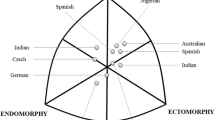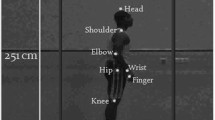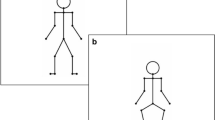Abstract
The present study investigated the expert-novice difference in the organization of upper-limb movement for the key-depression on the piano. Kinematic and electromyographic recordings were made while experts (N = 7) and novices (N = 7) of classical-piano players performed a right hand octave keystroke to produce four different sound dynamics. The joint torque generated at the key-bottom moment (key-force torque) was also estimated. At all sound dynamics, the experts showed a larger finger attack angle, more flexed shoulder, wrist, and MP joints, more extended elbow joint, and smaller key-force torque at the MP joint than the novices. The level of co-activation in the finger flexor–extensor muscles during the period prior to the key-bottom moment was also lower for the experts. To attain the large attack angle by the experts, as the fingertip depressed the key to the bottom, their shoulder was actively flexed, the forearm was thrust forward, and the hand was rotated forward. The novices, on the other hand, actively extended their shoulder to move the forearm and hand downward to depress the key. These results confirmed a substantial difference in the key-depression movement organization between the experts and novices. These findings also suggest that experts use a synergistically organized multi-joint limb motion that allows them to minimize the biomechanical load and muscular effort to the distal muscles. The novices, on the other hand, tend to rely on a rudimentary synergy of joint motion developed through daily experience.










Similar content being viewed by others
References
Altenmuller E (2003) Focal dystonia: advances in brain imaging and understanding of fine motor control in musicians. Hand Clin 19:523–538
Askenfelt A, Jannson EV (1991) From touch to string vibrations. II: The motion of the key and hammer. J Acoust Soc Am 90:2383–2393
Bagesteiro LB, Sainburg RL (2002) Handedness: dominant arm advantages in control of limb dynamics. J Neurophysiol 88:2408–2421
Bragge P, Bialocerkowski A, McMeeken J (2006) A systematic review of prevalence and risk factors associated with playing-related musculoskeletal disorders in pianists. Occup Med (Lond) 56:28–38
Debicki DB, Gribble PL, Watts S, Hore J (2004) Kinematics of wrist joint flexion in overarm throws made by skilled subjects. Exp Brain Res 154:382–394
Dennerlein JT (2005) Finger flexor tendon forces are a complex function of finger joint motions and fingertip forces. J Hand Ther 18:120–127
Dennerlein JT, Kingma I, Visser B, van Dieen JH (2007) The contribution of the wrist, elbow and shoulder joints to single-finger tapping. J Biomech 40:3013–3022
Dounskaia N (2005) The internal model and the leading joint hypothesis: implications for control of multi-joint movements. Exp Brain Res 166:1–16
Furuya S, Kinoshita H (2007) Roles of proximal-to-distal sequential organization of the upper limb segments in striking the keys by expert pianists. Neurosci Lett 421:264–269
Furuya S, Aoki T, Kinoshita H (2006a) Control of upper extremity movements in expert pianists when striking the piano keys at various sound volume and striking tempo. J Biomechanism 30:151–155 (in Japanese with English abstract)
Furuya S, Nakahara H, Aoki T, Kinoshita H (2006b) Prevalence and causal factors of playing-related musculoskeletal disorders of the upper extremity and trunk among Japanese pianists and piano students. Med Probl Perform Art 21:112–117
Goble JA, Zhang Y, Shimansky Y, Sharma S, Dounskaia NV (2007) Directional biases reveal utilization of arm’s biomechanical properties for optimization of motor behavior. J Neurophysiol (in press)
Graham KM, Moore KD, Cabel DW, Gribble PL, Cisek P, Scott SH (2003) Kinematics and kinetics of multijoint reaching in nonhuman primates. J Neurophysiol 89:2667–2677
Gray S, Watts S, Debicki D, Hore J (2006) Comparison of kinematics in skilled and unskilled arms of the same recreational baseball players. J Sports Sci 24:1183–1194
Harding DC, Brandt KD, Hillberry BM (1989) Minimization of finger joint forces and tendon tensions in pianists. Med Probl Perform Art 4:103–104
Harding DC, Brandt KD, Hillberry BM (1993) Finger joint force minimization in pianists using optimization techniques. J Biomech 26:1403–1412
Herring RM, Chapman AE (1992) Effects of changes in segmental values and timing of both torque and torque reversal in simulated throws. J Biomech 25:1173–1184
Herzog W (2000) Muscle properties and coordination during voluntary movement. J Sports Sci 18:141–152
Hirashima M, Ohgane K, Kudo K, Hase K, Ohtsuki T (2003) Counteractive relationship between the interaction torque and muscle torque at the wrist is predestined in ball-throwing. J Neurophysiol 90:1449–1463
Hirashima M, Kudo K, Watarai K, Ohtsuki T (2007) Control of 3D limb dynamics in unconstrained overarm throws of different speeds performed by skilled baseball players. J Neurophysiol 97:680–691
Hore J, Debicki DB, Watts S (2005a) Braking of elbow extension in fast overarm throws made by skilled and unskilled subjects. Exp Brain Res 164:365–375
Hore J, O’Brien M, Watts S (2005b) Control of joint rotations in overarm throws of different speeds made by dominant and nondominant arms. J Neurophysiol 94:3975–3986
Jindrich DL, Balakrishnan AD, Dennerlein JT (2004) Effects of keyswitch design and finger posture on finger joint kinematics and dynamics during tapping on computer keyswitches. Clin Biomech (Bristol, Avon) 19:600–608
Kay BA, Turvey MT, Meijer OG (2003) An early oscillator model: studies on the biodynamics of the piano strike (Bernstein & Popova, 1930). Motor Control 7:1–45
Kellis E, Arabatzi F, Papadopoulos C (2003) Muscle co-activation around the knee in drop jumping using the co-contraction index. J Electromyogr Kinesiol 13:229–238
Münte TF, Altenmüller E, Jäncke L (2002) The musician’s brain as a model of neuroplasticity. Nat Rev Neurosci 3:473–478
Oldfield RC (1971) The assessment and analysis of handedness: the Edinburgh inventory. Neurophychologia 9:97–113
Prilutsky BI, Zatsiorsky VM (2002) Optimization-based models of muscle coordination. Exerc Sport Sci Rev 30:32–38
Sainburg RL, Kalakanis D (2000) Differences in control of limb dynamics during dominant and nondominant arm reaching. J Neurophysiol 83:2661–2675
Sandor G (1995) On piano playing: motion, sound, and expression. Schirmer, New York
Sforza C, Macrì C, Turci M, Grassi G, Ferrario VF (2003) Neuromuscular patterns of finger movements during piano playing. Definition of an experimental protocol. Ital J Anat Embryol 108:211–222
Acknowledgments
We thank to Drs. K. Hosoda (Osaka University), K. Kadota (ERATO), and N. Tabuchi (MIZUNO co.) for their critical comments and helpful and constructive suggestions on an earlier version of this manuscript. We also thank Drs. S. Aono and T. Matsuo (Osaka University) for their assistance in conducting the experiments.
Author information
Authors and Affiliations
Corresponding author
Appendix
Appendix
During the finger-key contacting period, torques (“key-force torque”) from key reaction force are generated at the joints of the upper extremity. The key-force torque can be calculated as follows:
where τ is the key-force torque, F is the key-force (F = [Fx,Fy]), and J is the Jacobian matrix described as follows:
where constants are described as follows:
- A :
-
length from shoulder to elbow
- B :
-
length from elbow to wrist
- C :
-
length from wrist to MP
- D :
-
length from MP to fingertip
- θ :
-
shoulder angle
- ϕ:
-
elbow angle
- ψ:
-
wrist angle
- φ:
-
MP angle
These constants were computed using the measured position data of each joint center at the moment of the key’s lowest position for each participant. For all participants, the key-force torque was then computed at all loudness levels while a given amount of key reaction force was assumed to be applied to the fingertip at the moments of the key’s lowest position. For this purpose, the key reaction force at the moment of maximum key displacement was measured in a preliminary experiment using three expert and three novice piano players. A small uni-axial force transducer (Tec-gihan co., Kyoto, Japan) was fastened to the surface of the G3 key front using an adhesive strip, and it was struck by the thumb 10 times at the designated sound dynamics in the octave keystroke mode. The mean key reaction force at the p, mp, mf, and f levels were 2.3, 3.8, 6.5, 9.8 N, respectively, for the experts, and 2.3, 3.7, 6.4, and 10.1 N, respectively, for the novices. These values were doubled to approximate the sum of key reaction forces applied at the thumb and little finger, and inputted into the equation for each of the groups. The tangential force (Fx) was set to nil for simplicity of computation. The key-force torques at the MP, wrist, and elbow joints were computed. The shoulder joint torque was not computed because it was independent of the arm and hand postures.
Rights and permissions
About this article
Cite this article
Furuya, S., Kinoshita, H. Organization of the upper limb movement for piano key-depression differs between expert pianists and novice players. Exp Brain Res 185, 581–593 (2008). https://doi.org/10.1007/s00221-007-1184-9
Received:
Accepted:
Published:
Issue Date:
DOI: https://doi.org/10.1007/s00221-007-1184-9




